Nurses' Role in Paediatric Nutrition: Improving Infant Health Outcomes
VerifiedAdded on 2023/06/07
|10
|3214
|415
Report
AI Summary
This report explores the crucial role of nurses in paediatric nutrition, emphasizing the importance of proper feeding practices for infants and young children. It highlights that nutritional deficits in early childhood can lead to long-term health complications and impaired development, stressing the significance of breastfeeding and the need for nurses to have comprehensive knowledge in this area. The report discusses the nurse's role in addressing the nutritional needs of newborns, including exclusive breastfeeding for the first six months and the appropriate introduction of solid foods. Special considerations, such as feeding newborns with Hypoplastic Left Heart Syndrome, are also addressed, emphasizing the challenges and decisions nurses face in ensuring optimal nutrition for vulnerable infants. The report further examines the attitudes, intentions, and behaviors of nurses in neonatal care units, highlighting the importance of leadership, resources, and evidence-based practices to improve healthcare quality in paediatric nursing. Ultimately, the report underscores the need for continuous education, training, and a supportive organizational environment to enable nurses to provide the best possible care and reduce risks for neonates.
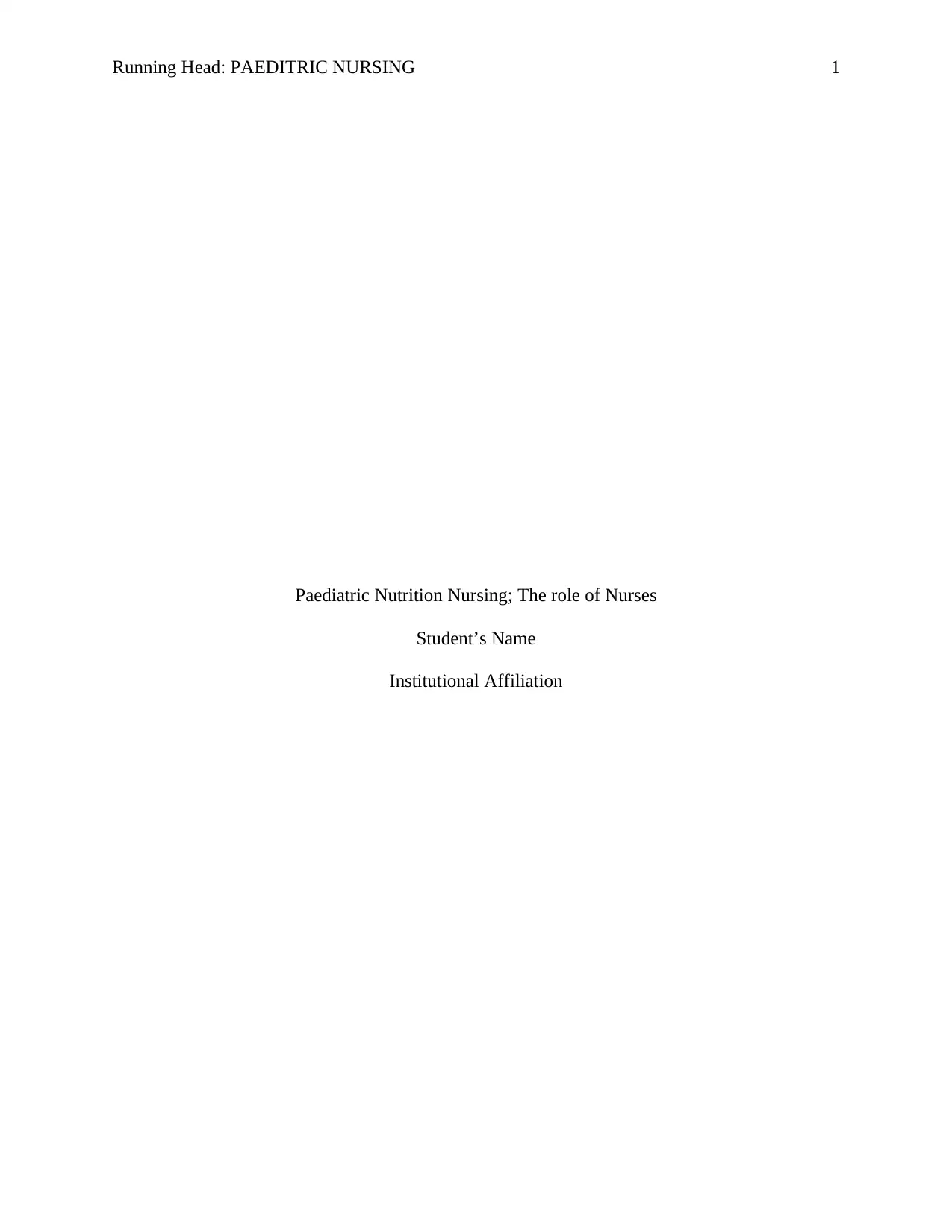
Running Head: PAEDITRIC NURSING 1
Paediatric Nutrition Nursing; The role of Nurses
Student’s Name
Institutional Affiliation
Paediatric Nutrition Nursing; The role of Nurses
Student’s Name
Institutional Affiliation
Paraphrase This Document
Need a fresh take? Get an instant paraphrase of this document with our AI Paraphraser
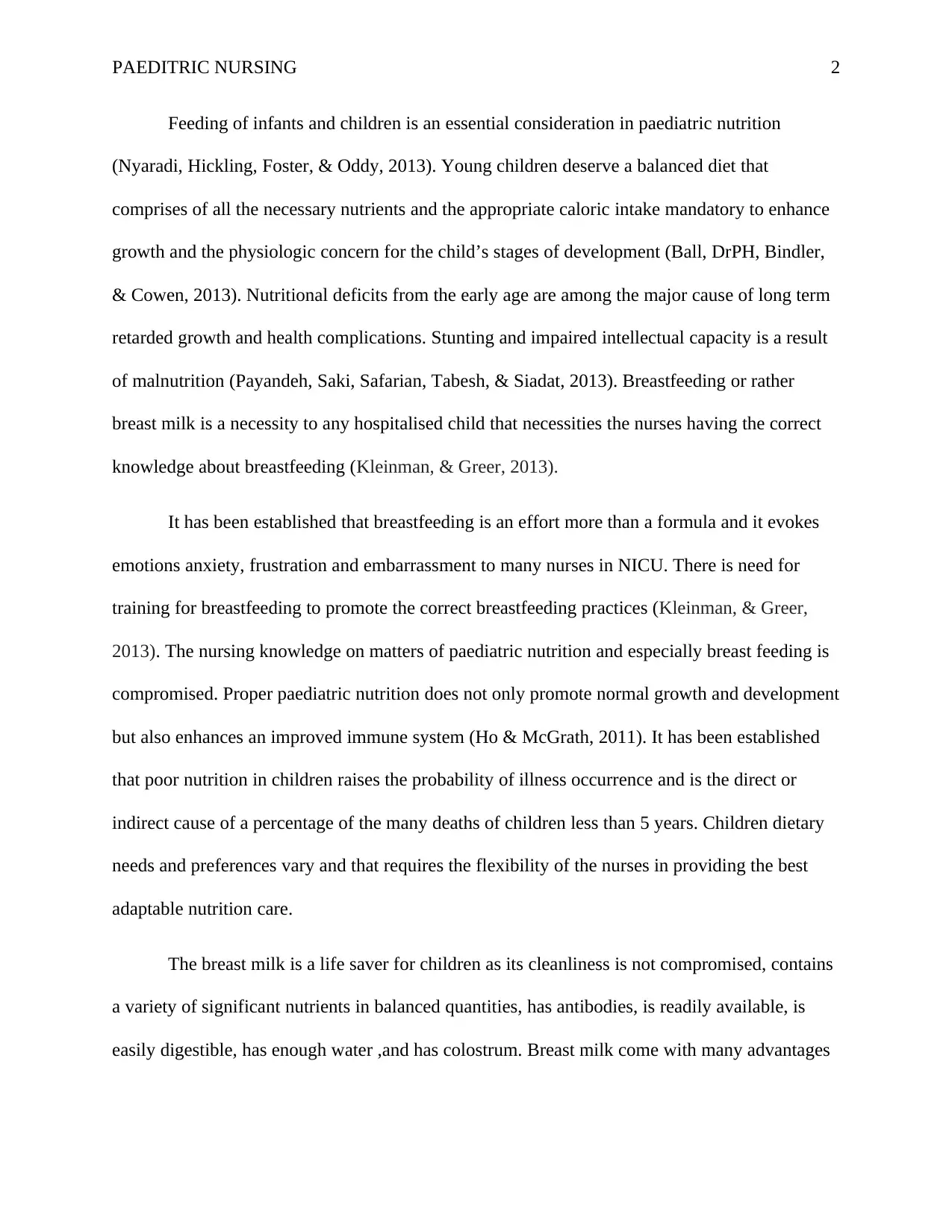
PAEDITRIC NURSING 2
Feeding of infants and children is an essential consideration in paediatric nutrition
(Nyaradi, Hickling, Foster, & Oddy, 2013). Young children deserve a balanced diet that
comprises of all the necessary nutrients and the appropriate caloric intake mandatory to enhance
growth and the physiologic concern for the child’s stages of development (Ball, DrPH, Bindler,
& Cowen, 2013). Nutritional deficits from the early age are among the major cause of long term
retarded growth and health complications. Stunting and impaired intellectual capacity is a result
of malnutrition (Payandeh, Saki, Safarian, Tabesh, & Siadat, 2013). Breastfeeding or rather
breast milk is a necessity to any hospitalised child that necessities the nurses having the correct
knowledge about breastfeeding (Kleinman, & Greer, 2013).
It has been established that breastfeeding is an effort more than a formula and it evokes
emotions anxiety, frustration and embarrassment to many nurses in NICU. There is need for
training for breastfeeding to promote the correct breastfeeding practices (Kleinman, & Greer,
2013). The nursing knowledge on matters of paediatric nutrition and especially breast feeding is
compromised. Proper paediatric nutrition does not only promote normal growth and development
but also enhances an improved immune system (Ho & McGrath, 2011). It has been established
that poor nutrition in children raises the probability of illness occurrence and is the direct or
indirect cause of a percentage of the many deaths of children less than 5 years. Children dietary
needs and preferences vary and that requires the flexibility of the nurses in providing the best
adaptable nutrition care.
The breast milk is a life saver for children as its cleanliness is not compromised, contains
a variety of significant nutrients in balanced quantities, has antibodies, is readily available, is
easily digestible, has enough water ,and has colostrum. Breast milk come with many advantages
Feeding of infants and children is an essential consideration in paediatric nutrition
(Nyaradi, Hickling, Foster, & Oddy, 2013). Young children deserve a balanced diet that
comprises of all the necessary nutrients and the appropriate caloric intake mandatory to enhance
growth and the physiologic concern for the child’s stages of development (Ball, DrPH, Bindler,
& Cowen, 2013). Nutritional deficits from the early age are among the major cause of long term
retarded growth and health complications. Stunting and impaired intellectual capacity is a result
of malnutrition (Payandeh, Saki, Safarian, Tabesh, & Siadat, 2013). Breastfeeding or rather
breast milk is a necessity to any hospitalised child that necessities the nurses having the correct
knowledge about breastfeeding (Kleinman, & Greer, 2013).
It has been established that breastfeeding is an effort more than a formula and it evokes
emotions anxiety, frustration and embarrassment to many nurses in NICU. There is need for
training for breastfeeding to promote the correct breastfeeding practices (Kleinman, & Greer,
2013). The nursing knowledge on matters of paediatric nutrition and especially breast feeding is
compromised. Proper paediatric nutrition does not only promote normal growth and development
but also enhances an improved immune system (Ho & McGrath, 2011). It has been established
that poor nutrition in children raises the probability of illness occurrence and is the direct or
indirect cause of a percentage of the many deaths of children less than 5 years. Children dietary
needs and preferences vary and that requires the flexibility of the nurses in providing the best
adaptable nutrition care.
The breast milk is a life saver for children as its cleanliness is not compromised, contains
a variety of significant nutrients in balanced quantities, has antibodies, is readily available, is
easily digestible, has enough water ,and has colostrum. Breast milk come with many advantages
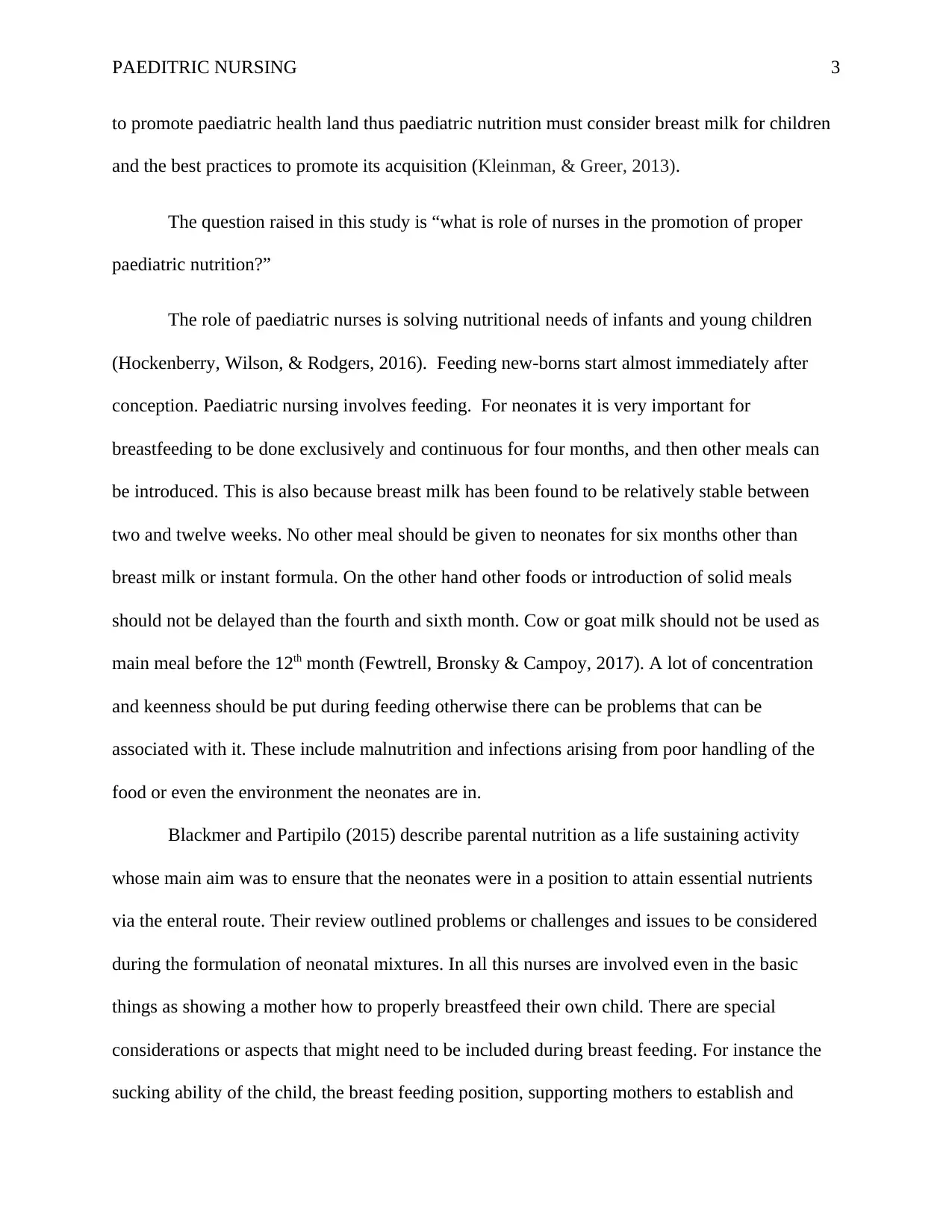
PAEDITRIC NURSING 3
to promote paediatric health land thus paediatric nutrition must consider breast milk for children
and the best practices to promote its acquisition (Kleinman, & Greer, 2013).
The question raised in this study is “what is role of nurses in the promotion of proper
paediatric nutrition?”
The role of paediatric nurses is solving nutritional needs of infants and young children
(Hockenberry, Wilson, & Rodgers, 2016). Feeding new-borns start almost immediately after
conception. Paediatric nursing involves feeding. For neonates it is very important for
breastfeeding to be done exclusively and continuous for four months, and then other meals can
be introduced. This is also because breast milk has been found to be relatively stable between
two and twelve weeks. No other meal should be given to neonates for six months other than
breast milk or instant formula. On the other hand other foods or introduction of solid meals
should not be delayed than the fourth and sixth month. Cow or goat milk should not be used as
main meal before the 12th month (Fewtrell, Bronsky & Campoy, 2017). A lot of concentration
and keenness should be put during feeding otherwise there can be problems that can be
associated with it. These include malnutrition and infections arising from poor handling of the
food or even the environment the neonates are in.
Blackmer and Partipilo (2015) describe parental nutrition as a life sustaining activity
whose main aim was to ensure that the neonates were in a position to attain essential nutrients
via the enteral route. Their review outlined problems or challenges and issues to be considered
during the formulation of neonatal mixtures. In all this nurses are involved even in the basic
things as showing a mother how to properly breastfeed their own child. There are special
considerations or aspects that might need to be included during breast feeding. For instance the
sucking ability of the child, the breast feeding position, supporting mothers to establish and
to promote paediatric health land thus paediatric nutrition must consider breast milk for children
and the best practices to promote its acquisition (Kleinman, & Greer, 2013).
The question raised in this study is “what is role of nurses in the promotion of proper
paediatric nutrition?”
The role of paediatric nurses is solving nutritional needs of infants and young children
(Hockenberry, Wilson, & Rodgers, 2016). Feeding new-borns start almost immediately after
conception. Paediatric nursing involves feeding. For neonates it is very important for
breastfeeding to be done exclusively and continuous for four months, and then other meals can
be introduced. This is also because breast milk has been found to be relatively stable between
two and twelve weeks. No other meal should be given to neonates for six months other than
breast milk or instant formula. On the other hand other foods or introduction of solid meals
should not be delayed than the fourth and sixth month. Cow or goat milk should not be used as
main meal before the 12th month (Fewtrell, Bronsky & Campoy, 2017). A lot of concentration
and keenness should be put during feeding otherwise there can be problems that can be
associated with it. These include malnutrition and infections arising from poor handling of the
food or even the environment the neonates are in.
Blackmer and Partipilo (2015) describe parental nutrition as a life sustaining activity
whose main aim was to ensure that the neonates were in a position to attain essential nutrients
via the enteral route. Their review outlined problems or challenges and issues to be considered
during the formulation of neonatal mixtures. In all this nurses are involved even in the basic
things as showing a mother how to properly breastfeed their own child. There are special
considerations or aspects that might need to be included during breast feeding. For instance the
sucking ability of the child, the breast feeding position, supporting mothers to establish and
⊘ This is a preview!⊘
Do you want full access?
Subscribe today to unlock all pages.

Trusted by 1+ million students worldwide
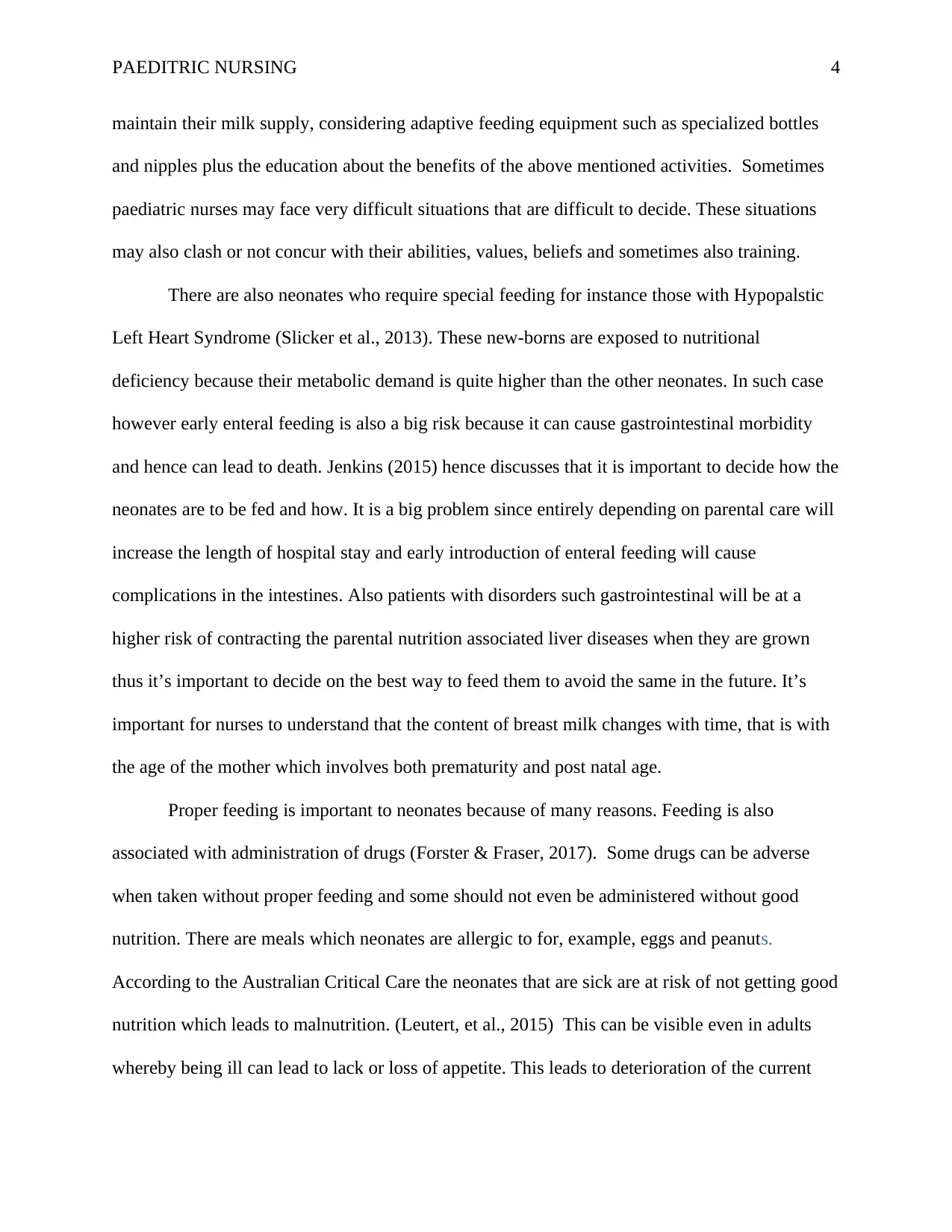
PAEDITRIC NURSING 4
maintain their milk supply, considering adaptive feeding equipment such as specialized bottles
and nipples plus the education about the benefits of the above mentioned activities. Sometimes
paediatric nurses may face very difficult situations that are difficult to decide. These situations
may also clash or not concur with their abilities, values, beliefs and sometimes also training.
There are also neonates who require special feeding for instance those with Hypopalstic
Left Heart Syndrome (Slicker et al., 2013). These new-borns are exposed to nutritional
deficiency because their metabolic demand is quite higher than the other neonates. In such case
however early enteral feeding is also a big risk because it can cause gastrointestinal morbidity
and hence can lead to death. Jenkins (2015) hence discusses that it is important to decide how the
neonates are to be fed and how. It is a big problem since entirely depending on parental care will
increase the length of hospital stay and early introduction of enteral feeding will cause
complications in the intestines. Also patients with disorders such gastrointestinal will be at a
higher risk of contracting the parental nutrition associated liver diseases when they are grown
thus it’s important to decide on the best way to feed them to avoid the same in the future. It’s
important for nurses to understand that the content of breast milk changes with time, that is with
the age of the mother which involves both prematurity and post natal age.
Proper feeding is important to neonates because of many reasons. Feeding is also
associated with administration of drugs (Forster & Fraser, 2017). Some drugs can be adverse
when taken without proper feeding and some should not even be administered without good
nutrition. There are meals which neonates are allergic to for, example, eggs and peanuts.
According to the Australian Critical Care the neonates that are sick are at risk of not getting good
nutrition which leads to malnutrition. (Leutert, et al., 2015) This can be visible even in adults
whereby being ill can lead to lack or loss of appetite. This leads to deterioration of the current
maintain their milk supply, considering adaptive feeding equipment such as specialized bottles
and nipples plus the education about the benefits of the above mentioned activities. Sometimes
paediatric nurses may face very difficult situations that are difficult to decide. These situations
may also clash or not concur with their abilities, values, beliefs and sometimes also training.
There are also neonates who require special feeding for instance those with Hypopalstic
Left Heart Syndrome (Slicker et al., 2013). These new-borns are exposed to nutritional
deficiency because their metabolic demand is quite higher than the other neonates. In such case
however early enteral feeding is also a big risk because it can cause gastrointestinal morbidity
and hence can lead to death. Jenkins (2015) hence discusses that it is important to decide how the
neonates are to be fed and how. It is a big problem since entirely depending on parental care will
increase the length of hospital stay and early introduction of enteral feeding will cause
complications in the intestines. Also patients with disorders such gastrointestinal will be at a
higher risk of contracting the parental nutrition associated liver diseases when they are grown
thus it’s important to decide on the best way to feed them to avoid the same in the future. It’s
important for nurses to understand that the content of breast milk changes with time, that is with
the age of the mother which involves both prematurity and post natal age.
Proper feeding is important to neonates because of many reasons. Feeding is also
associated with administration of drugs (Forster & Fraser, 2017). Some drugs can be adverse
when taken without proper feeding and some should not even be administered without good
nutrition. There are meals which neonates are allergic to for, example, eggs and peanuts.
According to the Australian Critical Care the neonates that are sick are at risk of not getting good
nutrition which leads to malnutrition. (Leutert, et al., 2015) This can be visible even in adults
whereby being ill can lead to lack or loss of appetite. This leads to deterioration of the current
Paraphrase This Document
Need a fresh take? Get an instant paraphrase of this document with our AI Paraphraser
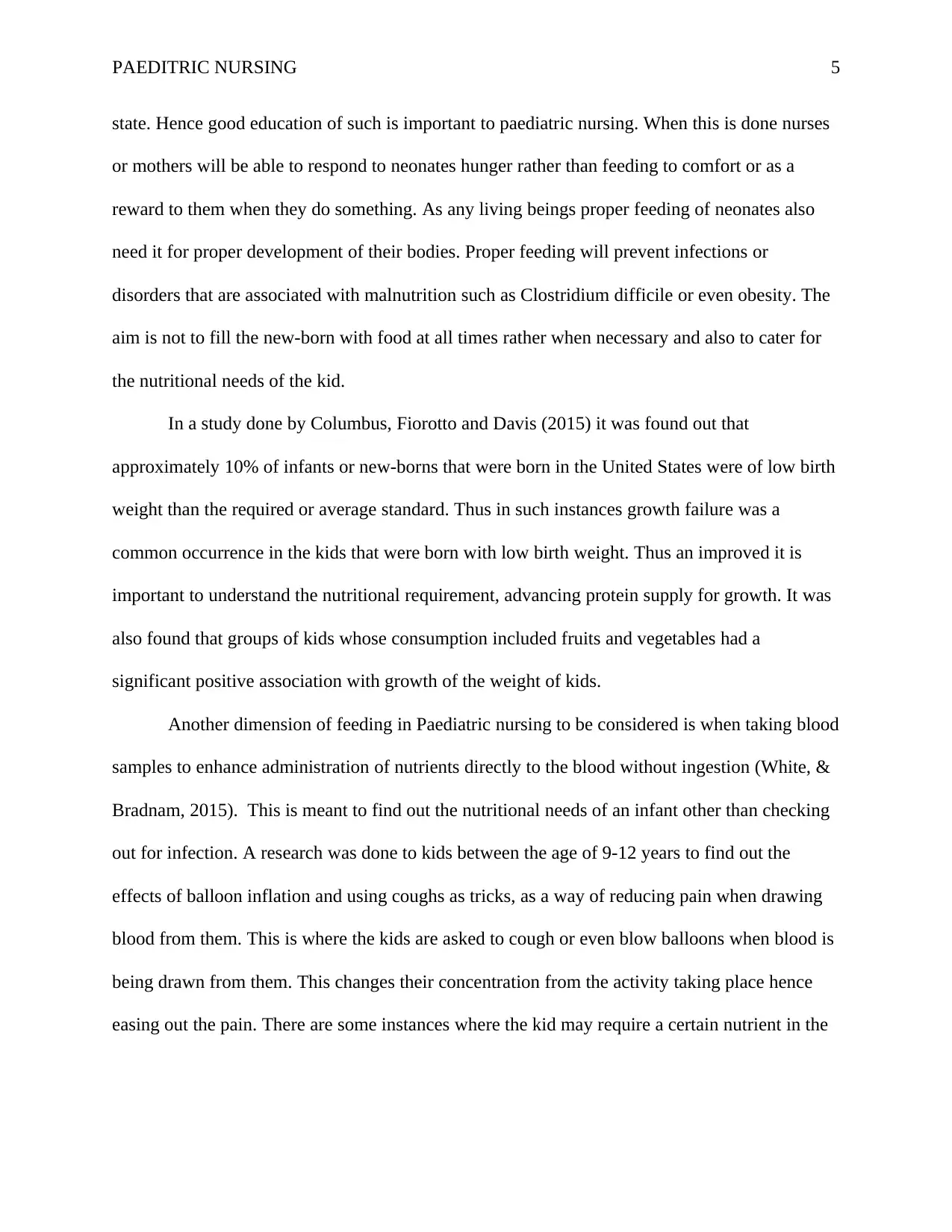
PAEDITRIC NURSING 5
state. Hence good education of such is important to paediatric nursing. When this is done nurses
or mothers will be able to respond to neonates hunger rather than feeding to comfort or as a
reward to them when they do something. As any living beings proper feeding of neonates also
need it for proper development of their bodies. Proper feeding will prevent infections or
disorders that are associated with malnutrition such as Clostridium difficile or even obesity. The
aim is not to fill the new-born with food at all times rather when necessary and also to cater for
the nutritional needs of the kid.
In a study done by Columbus, Fiorotto and Davis (2015) it was found out that
approximately 10% of infants or new-borns that were born in the United States were of low birth
weight than the required or average standard. Thus in such instances growth failure was a
common occurrence in the kids that were born with low birth weight. Thus an improved it is
important to understand the nutritional requirement, advancing protein supply for growth. It was
also found that groups of kids whose consumption included fruits and vegetables had a
significant positive association with growth of the weight of kids.
Another dimension of feeding in Paediatric nursing to be considered is when taking blood
samples to enhance administration of nutrients directly to the blood without ingestion (White, &
Bradnam, 2015). This is meant to find out the nutritional needs of an infant other than checking
out for infection. A research was done to kids between the age of 9-12 years to find out the
effects of balloon inflation and using coughs as tricks, as a way of reducing pain when drawing
blood from them. This is where the kids are asked to cough or even blow balloons when blood is
being drawn from them. This changes their concentration from the activity taking place hence
easing out the pain. There are some instances where the kid may require a certain nutrient in the
state. Hence good education of such is important to paediatric nursing. When this is done nurses
or mothers will be able to respond to neonates hunger rather than feeding to comfort or as a
reward to them when they do something. As any living beings proper feeding of neonates also
need it for proper development of their bodies. Proper feeding will prevent infections or
disorders that are associated with malnutrition such as Clostridium difficile or even obesity. The
aim is not to fill the new-born with food at all times rather when necessary and also to cater for
the nutritional needs of the kid.
In a study done by Columbus, Fiorotto and Davis (2015) it was found out that
approximately 10% of infants or new-borns that were born in the United States were of low birth
weight than the required or average standard. Thus in such instances growth failure was a
common occurrence in the kids that were born with low birth weight. Thus an improved it is
important to understand the nutritional requirement, advancing protein supply for growth. It was
also found that groups of kids whose consumption included fruits and vegetables had a
significant positive association with growth of the weight of kids.
Another dimension of feeding in Paediatric nursing to be considered is when taking blood
samples to enhance administration of nutrients directly to the blood without ingestion (White, &
Bradnam, 2015). This is meant to find out the nutritional needs of an infant other than checking
out for infection. A research was done to kids between the age of 9-12 years to find out the
effects of balloon inflation and using coughs as tricks, as a way of reducing pain when drawing
blood from them. This is where the kids are asked to cough or even blow balloons when blood is
being drawn from them. This changes their concentration from the activity taking place hence
easing out the pain. There are some instances where the kid may require a certain nutrient in the
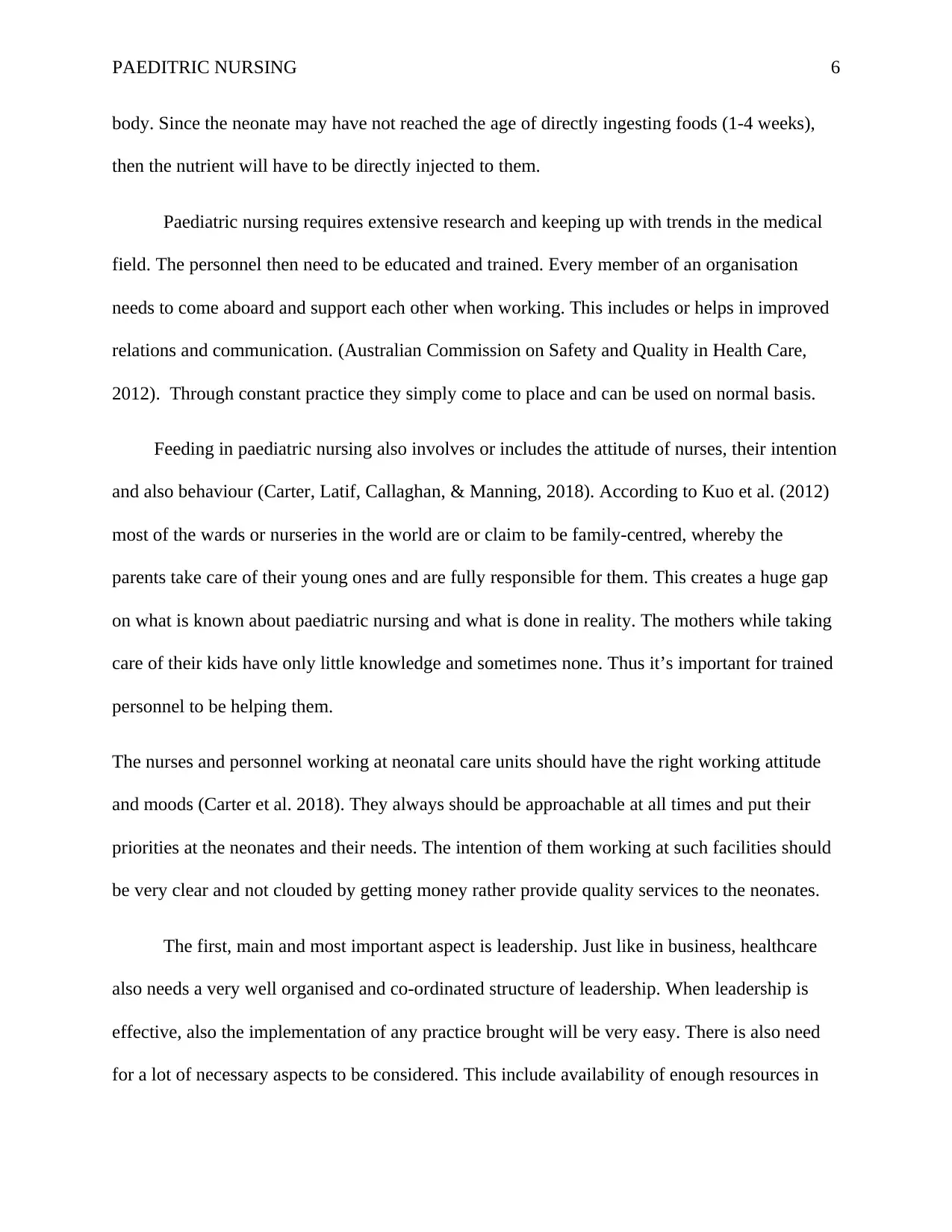
PAEDITRIC NURSING 6
body. Since the neonate may have not reached the age of directly ingesting foods (1-4 weeks),
then the nutrient will have to be directly injected to them.
Paediatric nursing requires extensive research and keeping up with trends in the medical
field. The personnel then need to be educated and trained. Every member of an organisation
needs to come aboard and support each other when working. This includes or helps in improved
relations and communication. (Australian Commission on Safety and Quality in Health Care,
2012). Through constant practice they simply come to place and can be used on normal basis.
Feeding in paediatric nursing also involves or includes the attitude of nurses, their intention
and also behaviour (Carter, Latif, Callaghan, & Manning, 2018). According to Kuo et al. (2012)
most of the wards or nurseries in the world are or claim to be family-centred, whereby the
parents take care of their young ones and are fully responsible for them. This creates a huge gap
on what is known about paediatric nursing and what is done in reality. The mothers while taking
care of their kids have only little knowledge and sometimes none. Thus it’s important for trained
personnel to be helping them.
The nurses and personnel working at neonatal care units should have the right working attitude
and moods (Carter et al. 2018). They always should be approachable at all times and put their
priorities at the neonates and their needs. The intention of them working at such facilities should
be very clear and not clouded by getting money rather provide quality services to the neonates.
The first, main and most important aspect is leadership. Just like in business, healthcare
also needs a very well organised and co-ordinated structure of leadership. When leadership is
effective, also the implementation of any practice brought will be very easy. There is also need
for a lot of necessary aspects to be considered. This include availability of enough resources in
body. Since the neonate may have not reached the age of directly ingesting foods (1-4 weeks),
then the nutrient will have to be directly injected to them.
Paediatric nursing requires extensive research and keeping up with trends in the medical
field. The personnel then need to be educated and trained. Every member of an organisation
needs to come aboard and support each other when working. This includes or helps in improved
relations and communication. (Australian Commission on Safety and Quality in Health Care,
2012). Through constant practice they simply come to place and can be used on normal basis.
Feeding in paediatric nursing also involves or includes the attitude of nurses, their intention
and also behaviour (Carter, Latif, Callaghan, & Manning, 2018). According to Kuo et al. (2012)
most of the wards or nurseries in the world are or claim to be family-centred, whereby the
parents take care of their young ones and are fully responsible for them. This creates a huge gap
on what is known about paediatric nursing and what is done in reality. The mothers while taking
care of their kids have only little knowledge and sometimes none. Thus it’s important for trained
personnel to be helping them.
The nurses and personnel working at neonatal care units should have the right working attitude
and moods (Carter et al. 2018). They always should be approachable at all times and put their
priorities at the neonates and their needs. The intention of them working at such facilities should
be very clear and not clouded by getting money rather provide quality services to the neonates.
The first, main and most important aspect is leadership. Just like in business, healthcare
also needs a very well organised and co-ordinated structure of leadership. When leadership is
effective, also the implementation of any practice brought will be very easy. There is also need
for a lot of necessary aspects to be considered. This include availability of enough resources in
⊘ This is a preview!⊘
Do you want full access?
Subscribe today to unlock all pages.

Trusted by 1+ million students worldwide
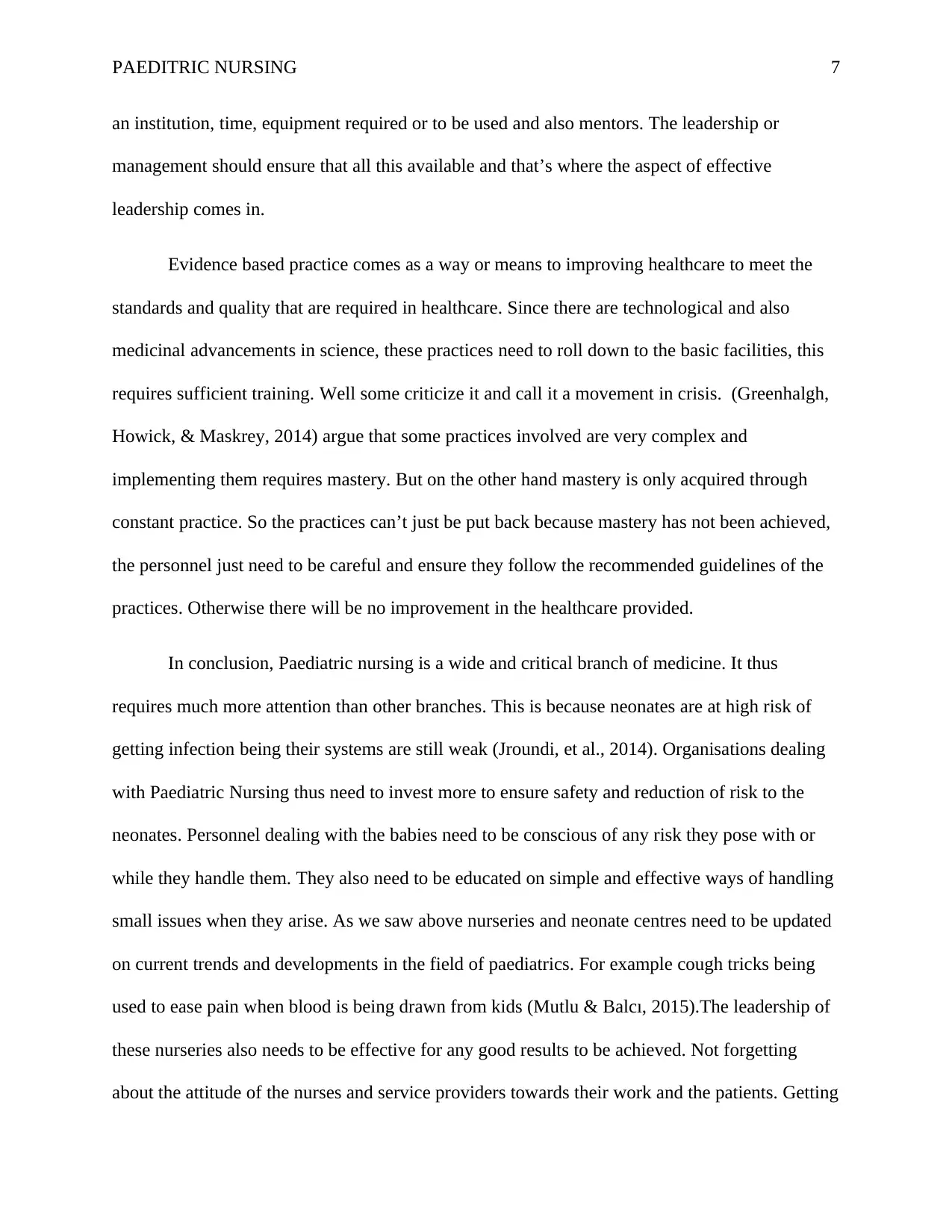
PAEDITRIC NURSING 7
an institution, time, equipment required or to be used and also mentors. The leadership or
management should ensure that all this available and that’s where the aspect of effective
leadership comes in.
Evidence based practice comes as a way or means to improving healthcare to meet the
standards and quality that are required in healthcare. Since there are technological and also
medicinal advancements in science, these practices need to roll down to the basic facilities, this
requires sufficient training. Well some criticize it and call it a movement in crisis. (Greenhalgh,
Howick, & Maskrey, 2014) argue that some practices involved are very complex and
implementing them requires mastery. But on the other hand mastery is only acquired through
constant practice. So the practices can’t just be put back because mastery has not been achieved,
the personnel just need to be careful and ensure they follow the recommended guidelines of the
practices. Otherwise there will be no improvement in the healthcare provided.
In conclusion, Paediatric nursing is a wide and critical branch of medicine. It thus
requires much more attention than other branches. This is because neonates are at high risk of
getting infection being their systems are still weak (Jroundi, et al., 2014). Organisations dealing
with Paediatric Nursing thus need to invest more to ensure safety and reduction of risk to the
neonates. Personnel dealing with the babies need to be conscious of any risk they pose with or
while they handle them. They also need to be educated on simple and effective ways of handling
small issues when they arise. As we saw above nurseries and neonate centres need to be updated
on current trends and developments in the field of paediatrics. For example cough tricks being
used to ease pain when blood is being drawn from kids (Mutlu & Balcı, 2015).The leadership of
these nurseries also needs to be effective for any good results to be achieved. Not forgetting
about the attitude of the nurses and service providers towards their work and the patients. Getting
an institution, time, equipment required or to be used and also mentors. The leadership or
management should ensure that all this available and that’s where the aspect of effective
leadership comes in.
Evidence based practice comes as a way or means to improving healthcare to meet the
standards and quality that are required in healthcare. Since there are technological and also
medicinal advancements in science, these practices need to roll down to the basic facilities, this
requires sufficient training. Well some criticize it and call it a movement in crisis. (Greenhalgh,
Howick, & Maskrey, 2014) argue that some practices involved are very complex and
implementing them requires mastery. But on the other hand mastery is only acquired through
constant practice. So the practices can’t just be put back because mastery has not been achieved,
the personnel just need to be careful and ensure they follow the recommended guidelines of the
practices. Otherwise there will be no improvement in the healthcare provided.
In conclusion, Paediatric nursing is a wide and critical branch of medicine. It thus
requires much more attention than other branches. This is because neonates are at high risk of
getting infection being their systems are still weak (Jroundi, et al., 2014). Organisations dealing
with Paediatric Nursing thus need to invest more to ensure safety and reduction of risk to the
neonates. Personnel dealing with the babies need to be conscious of any risk they pose with or
while they handle them. They also need to be educated on simple and effective ways of handling
small issues when they arise. As we saw above nurseries and neonate centres need to be updated
on current trends and developments in the field of paediatrics. For example cough tricks being
used to ease pain when blood is being drawn from kids (Mutlu & Balcı, 2015).The leadership of
these nurseries also needs to be effective for any good results to be achieved. Not forgetting
about the attitude of the nurses and service providers towards their work and the patients. Getting
Paraphrase This Document
Need a fresh take? Get an instant paraphrase of this document with our AI Paraphraser

PAEDITRIC NURSING 8
their priorities right when making decisions, is also a crucial aspect to provision of quality
healthcare, as this is the main mandate of the facilities. There needs to be enough mentors where
the young nurses can look up to and learn from so that skills are passed down to. Otherwise there
would be no learning taking place in the facilities which can be catastrophic (Gallego,
Westbrook, Dunn & Braithwaite, 2012).
their priorities right when making decisions, is also a crucial aspect to provision of quality
healthcare, as this is the main mandate of the facilities. There needs to be enough mentors where
the young nurses can look up to and learn from so that skills are passed down to. Otherwise there
would be no learning taking place in the facilities which can be catastrophic (Gallego,
Westbrook, Dunn & Braithwaite, 2012).
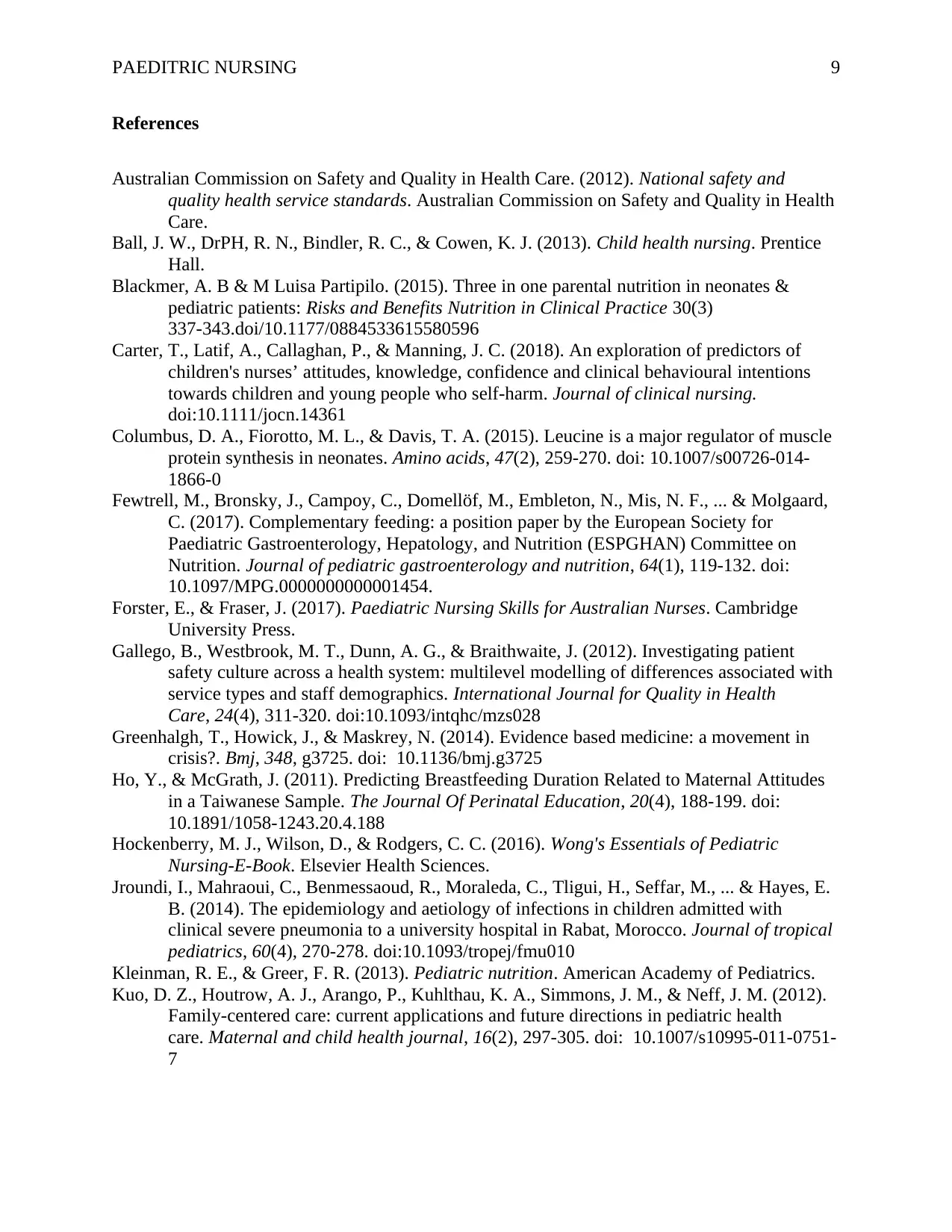
PAEDITRIC NURSING 9
References
Australian Commission on Safety and Quality in Health Care. (2012). National safety and
quality health service standards. Australian Commission on Safety and Quality in Health
Care.
Ball, J. W., DrPH, R. N., Bindler, R. C., & Cowen, K. J. (2013). Child health nursing. Prentice
Hall.
Blackmer, A. B & M Luisa Partipilo. (2015). Three in one parental nutrition in neonates &
pediatric patients: Risks and Benefits Nutrition in Clinical Practice 30(3)
337-343.doi/10.1177/0884533615580596
Carter, T., Latif, A., Callaghan, P., & Manning, J. C. (2018). An exploration of predictors of
children's nurses’ attitudes, knowledge, confidence and clinical behavioural intentions
towards children and young people who self‐harm. Journal of clinical nursing.
doi:10.1111/jocn.14361
Columbus, D. A., Fiorotto, M. L., & Davis, T. A. (2015). Leucine is a major regulator of muscle
protein synthesis in neonates. Amino acids, 47(2), 259-270. doi: 10.1007/s00726-014-
1866-0
Fewtrell, M., Bronsky, J., Campoy, C., Domellöf, M., Embleton, N., Mis, N. F., ... & Molgaard,
C. (2017). Complementary feeding: a position paper by the European Society for
Paediatric Gastroenterology, Hepatology, and Nutrition (ESPGHAN) Committee on
Nutrition. Journal of pediatric gastroenterology and nutrition, 64(1), 119-132. doi:
10.1097/MPG.0000000000001454.
Forster, E., & Fraser, J. (2017). Paediatric Nursing Skills for Australian Nurses. Cambridge
University Press.
Gallego, B., Westbrook, M. T., Dunn, A. G., & Braithwaite, J. (2012). Investigating patient
safety culture across a health system: multilevel modelling of differences associated with
service types and staff demographics. International Journal for Quality in Health
Care, 24(4), 311-320. doi:10.1093/intqhc/mzs028
Greenhalgh, T., Howick, J., & Maskrey, N. (2014). Evidence based medicine: a movement in
crisis?. Bmj, 348, g3725. doi: 10.1136/bmj.g3725
Ho, Y., & McGrath, J. (2011). Predicting Breastfeeding Duration Related to Maternal Attitudes
in a Taiwanese Sample. The Journal Of Perinatal Education, 20(4), 188-199. doi:
10.1891/1058-1243.20.4.188
Hockenberry, M. J., Wilson, D., & Rodgers, C. C. (2016). Wong's Essentials of Pediatric
Nursing-E-Book. Elsevier Health Sciences.
Jroundi, I., Mahraoui, C., Benmessaoud, R., Moraleda, C., Tligui, H., Seffar, M., ... & Hayes, E.
B. (2014). The epidemiology and aetiology of infections in children admitted with
clinical severe pneumonia to a university hospital in Rabat, Morocco. Journal of tropical
pediatrics, 60(4), 270-278. doi:10.1093/tropej/fmu010
Kleinman, R. E., & Greer, F. R. (2013). Pediatric nutrition. American Academy of Pediatrics.
Kuo, D. Z., Houtrow, A. J., Arango, P., Kuhlthau, K. A., Simmons, J. M., & Neff, J. M. (2012).
Family-centered care: current applications and future directions in pediatric health
care. Maternal and child health journal, 16(2), 297-305. doi: 10.1007/s10995-011-0751-
7
References
Australian Commission on Safety and Quality in Health Care. (2012). National safety and
quality health service standards. Australian Commission on Safety and Quality in Health
Care.
Ball, J. W., DrPH, R. N., Bindler, R. C., & Cowen, K. J. (2013). Child health nursing. Prentice
Hall.
Blackmer, A. B & M Luisa Partipilo. (2015). Three in one parental nutrition in neonates &
pediatric patients: Risks and Benefits Nutrition in Clinical Practice 30(3)
337-343.doi/10.1177/0884533615580596
Carter, T., Latif, A., Callaghan, P., & Manning, J. C. (2018). An exploration of predictors of
children's nurses’ attitudes, knowledge, confidence and clinical behavioural intentions
towards children and young people who self‐harm. Journal of clinical nursing.
doi:10.1111/jocn.14361
Columbus, D. A., Fiorotto, M. L., & Davis, T. A. (2015). Leucine is a major regulator of muscle
protein synthesis in neonates. Amino acids, 47(2), 259-270. doi: 10.1007/s00726-014-
1866-0
Fewtrell, M., Bronsky, J., Campoy, C., Domellöf, M., Embleton, N., Mis, N. F., ... & Molgaard,
C. (2017). Complementary feeding: a position paper by the European Society for
Paediatric Gastroenterology, Hepatology, and Nutrition (ESPGHAN) Committee on
Nutrition. Journal of pediatric gastroenterology and nutrition, 64(1), 119-132. doi:
10.1097/MPG.0000000000001454.
Forster, E., & Fraser, J. (2017). Paediatric Nursing Skills for Australian Nurses. Cambridge
University Press.
Gallego, B., Westbrook, M. T., Dunn, A. G., & Braithwaite, J. (2012). Investigating patient
safety culture across a health system: multilevel modelling of differences associated with
service types and staff demographics. International Journal for Quality in Health
Care, 24(4), 311-320. doi:10.1093/intqhc/mzs028
Greenhalgh, T., Howick, J., & Maskrey, N. (2014). Evidence based medicine: a movement in
crisis?. Bmj, 348, g3725. doi: 10.1136/bmj.g3725
Ho, Y., & McGrath, J. (2011). Predicting Breastfeeding Duration Related to Maternal Attitudes
in a Taiwanese Sample. The Journal Of Perinatal Education, 20(4), 188-199. doi:
10.1891/1058-1243.20.4.188
Hockenberry, M. J., Wilson, D., & Rodgers, C. C. (2016). Wong's Essentials of Pediatric
Nursing-E-Book. Elsevier Health Sciences.
Jroundi, I., Mahraoui, C., Benmessaoud, R., Moraleda, C., Tligui, H., Seffar, M., ... & Hayes, E.
B. (2014). The epidemiology and aetiology of infections in children admitted with
clinical severe pneumonia to a university hospital in Rabat, Morocco. Journal of tropical
pediatrics, 60(4), 270-278. doi:10.1093/tropej/fmu010
Kleinman, R. E., & Greer, F. R. (2013). Pediatric nutrition. American Academy of Pediatrics.
Kuo, D. Z., Houtrow, A. J., Arango, P., Kuhlthau, K. A., Simmons, J. M., & Neff, J. M. (2012).
Family-centered care: current applications and future directions in pediatric health
care. Maternal and child health journal, 16(2), 297-305. doi: 10.1007/s10995-011-0751-
7
⊘ This is a preview!⊘
Do you want full access?
Subscribe today to unlock all pages.

Trusted by 1+ million students worldwide
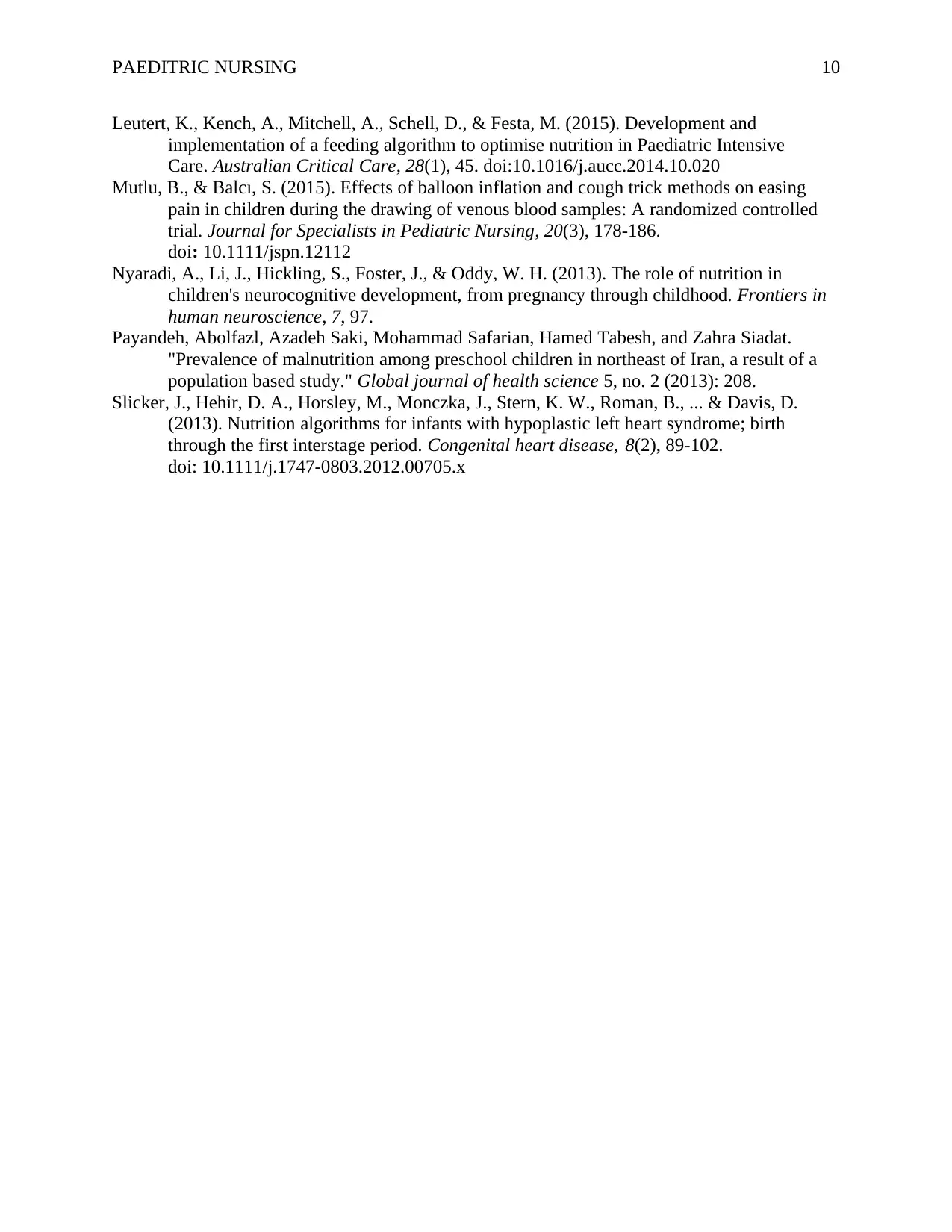
PAEDITRIC NURSING 10
Leutert, K., Kench, A., Mitchell, A., Schell, D., & Festa, M. (2015). Development and
implementation of a feeding algorithm to optimise nutrition in Paediatric Intensive
Care. Australian Critical Care, 28(1), 45. doi:10.1016/j.aucc.2014.10.020
Mutlu, B., & Balcı, S. (2015). Effects of balloon inflation and cough trick methods on easing
pain in children during the drawing of venous blood samples: A randomized controlled
trial. Journal for Specialists in Pediatric Nursing, 20(3), 178-186.
doi: 10.1111/jspn.12112
Nyaradi, A., Li, J., Hickling, S., Foster, J., & Oddy, W. H. (2013). The role of nutrition in
children's neurocognitive development, from pregnancy through childhood. Frontiers in
human neuroscience, 7, 97.
Payandeh, Abolfazl, Azadeh Saki, Mohammad Safarian, Hamed Tabesh, and Zahra Siadat.
"Prevalence of malnutrition among preschool children in northeast of Iran, a result of a
population based study." Global journal of health science 5, no. 2 (2013): 208.
Slicker, J., Hehir, D. A., Horsley, M., Monczka, J., Stern, K. W., Roman, B., ... & Davis, D.
(2013). Nutrition algorithms for infants with hypoplastic left heart syndrome; birth
through the first interstage period. Congenital heart disease, 8(2), 89-102.
doi: 10.1111/j.1747-0803.2012.00705.x
Leutert, K., Kench, A., Mitchell, A., Schell, D., & Festa, M. (2015). Development and
implementation of a feeding algorithm to optimise nutrition in Paediatric Intensive
Care. Australian Critical Care, 28(1), 45. doi:10.1016/j.aucc.2014.10.020
Mutlu, B., & Balcı, S. (2015). Effects of balloon inflation and cough trick methods on easing
pain in children during the drawing of venous blood samples: A randomized controlled
trial. Journal for Specialists in Pediatric Nursing, 20(3), 178-186.
doi: 10.1111/jspn.12112
Nyaradi, A., Li, J., Hickling, S., Foster, J., & Oddy, W. H. (2013). The role of nutrition in
children's neurocognitive development, from pregnancy through childhood. Frontiers in
human neuroscience, 7, 97.
Payandeh, Abolfazl, Azadeh Saki, Mohammad Safarian, Hamed Tabesh, and Zahra Siadat.
"Prevalence of malnutrition among preschool children in northeast of Iran, a result of a
population based study." Global journal of health science 5, no. 2 (2013): 208.
Slicker, J., Hehir, D. A., Horsley, M., Monczka, J., Stern, K. W., Roman, B., ... & Davis, D.
(2013). Nutrition algorithms for infants with hypoplastic left heart syndrome; birth
through the first interstage period. Congenital heart disease, 8(2), 89-102.
doi: 10.1111/j.1747-0803.2012.00705.x
1 out of 10
Related Documents
Your All-in-One AI-Powered Toolkit for Academic Success.
+13062052269
info@desklib.com
Available 24*7 on WhatsApp / Email
![[object Object]](/_next/static/media/star-bottom.7253800d.svg)
Unlock your academic potential
Copyright © 2020–2025 A2Z Services. All Rights Reserved. Developed and managed by ZUCOL.





